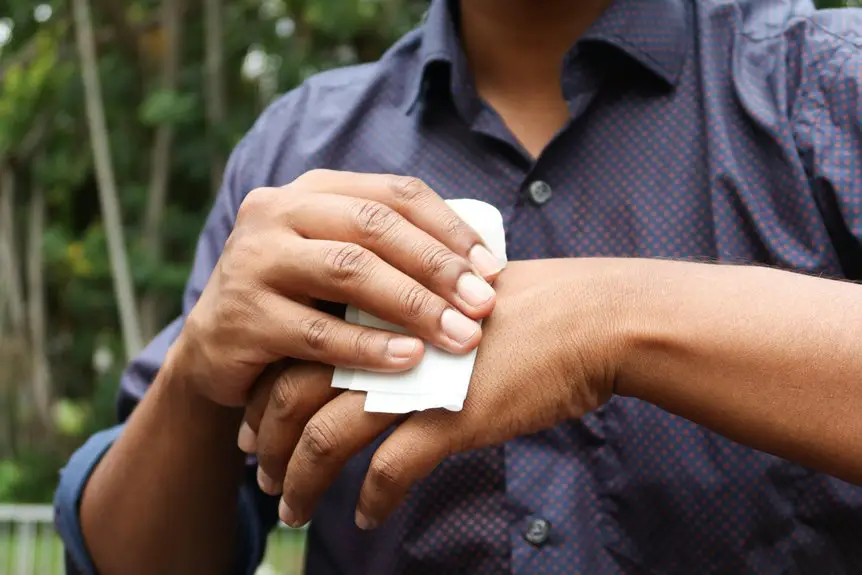Yes, polyester fabric can pill, forming small balls on its surface from friction. To prevent this, wash in cold water on a gentle cycle, avoid fabric softeners, and separate heavier fabrics to reduce rubbing. Air drying or using low heat is best for reducing damage. For removal, consider using a fabric shaver or scissors to snip off the pills. There’s plenty more to learn about maximizing your polyester garments’ lifespan and keeping them looking great.
Table of Contents
Key Takeaways
- Yes, polyester fabric can pill due to friction, especially in high-contact areas like underarms and sides.
- To prevent pilling, wash polyester in cold water on a gentle cycle and avoid fabric softeners.
- Use low heat settings or air drying to reduce damage during drying and limit pilling.
- Regularly remove pills with a fabric shaver, lint roller, or fine-toothed comb for maintenance.
- Store polyester items in a cool, dry place, away from direct sunlight to minimize pilling.
Understanding Pilling in Polyester Fabric
While you might enjoy the durability and versatility of polyester fabric, understanding pilling is vital for maintaining its appearance. Pilling occurs when fibers in the fabric rub against each other, creating small balls or “pills” on the surface. These pills can make your clothing look worn and less appealing.
Polyester, while strong, can still be susceptible to pilling, especially with frequent wear or washing. You may notice pilling more on areas that experience friction, such as underarms or the sides of garments.
To keep your polyester items looking fresh, it’s important to recognize pilling early. Regularly check for pills and consider using a fabric shaver or lint roller to remove them. This simple step can enhance your fabric’s longevity and visual appeal.
Factors Contributing to Pilling
Several factors contribute to pilling in polyester fabric, and understanding them can help you take proactive measures.
First, the quality of the polyester matters; lower-quality fabrics often have shorter fibers that can easily tangle and form pills.
Additionally, the type of use plays a role; frequent friction from movement or rubbing against other surfaces can increase pilling.
Washing and drying methods also impact pilling; using harsh detergents or high heat can break down fibers and promote pill formation.
Finally, the blend of materials in your polyester fabric can make a difference; blends with natural fibers may pill less than pure polyester.
Effective Prevention Tips
To keep your polyester fabric looking its best, you can adopt several effective prevention tips.
First, always wash your polyester items in cold water on a gentle cycle. This minimizes friction, which can cause pilling.
Avoid using fabric softeners, as they can actually lead to more pilling over time.
When drying, opt for a low heat setting or air dry to prevent damage.
Additionally, try to separate your polyester garments from heavier fabrics in the wash, as they can create friction against each other.
Finally, store your polyester items in a cool, dry place, away from direct sunlight.
Methods for Removing Pills
Removing pills from polyester fabric can breathe new life into your garments.
Start by using a fabric shaver or lint remover; these tools efficiently remove pills without damaging the fabric. If you don’t have one, try using a pair of scissors to carefully snip off the pills. Just be cautious not to cut the fabric itself.
Another option is to use a fine-toothed comb or a pumice stone, gently rubbing over the surface to lift the pills away. You can also place your garment inside a mesh laundry bag before washing to minimize future pilling.
Whichever method you choose, take your time to guarantee a thorough job, and enjoy your revitalized polyester pieces!
Comparing Polyester to Other Fabrics
While many people appreciate polyester for its durability and affordability, it’s essential to compare it with other fabrics to understand its unique characteristics.
Cotton, for example, is breathable and soft but may wrinkle easily and lacks polyester’s resistance to shrinking.
Wool offers warmth and moisture-wicking properties but can be itchy and requires special care.
Linen is lightweight and comfortable in hot weather, yet it’s prone to wrinkles and can be less durable than polyester.
When it comes to maintenance, polyester often wins, as it’s easy to wash and quick-drying.
Ultimately, your choice depends on your specific needs, whether you prioritize comfort, care, or durability.
Understanding these differences helps you make informed decisions when shopping for fabrics.
Frequently Asked Questions
Can Pilling Occur on Blended Fabrics Containing Polyester?
Oh, absolutely! If you’ve ever seen a sweater transform into a fuzzy monster, you know blended fabrics with polyester can pill. Those pesky fibers love to cling together, creating an annoying, textured surface you can’t ignore!
Is Pilling More Common on Dark or Light-Colored Polyester Fabrics?
Pilling can happen on both dark and light-colored polyester fabrics, but it’s often more noticeable on dark colors. You might find it helpful to choose lighter shades if you want to minimize the appearance of pilling.
How Does Washing Temperature Affect Pilling on Polyester?
Washing polyester at higher temperatures can increase pilling, as it causes fibers to loosen and tangle. Stick to cold or warm water to minimize this effect and keep your fabric looking smooth and new longer.
Do Fabric Softeners Prevent or Worsen Pilling on Polyester?
Fabric softeners can sometimes soothe the static, but they might also amplify pilling on polyester. You’ll need to test your textiles; what works wonders for one fabric may worsen wear and tear on another.
Can Pilling Be a Sign of Low-Quality Polyester Fabric?
Yes, pilling can indicate low-quality polyester fabric. When fibers aren’t tightly woven or durable, they tend to break and form those annoying little balls. Choosing higher-quality options can help you avoid this issue.
- The Use of Nonwovens in Construction and Civil Engineering - July 11, 2025
- The Use of Nonwovens in Construction and Civil Engineering - July 11, 2025
- The Use of Nonwovens in Construction and Civil Engineering - July 11, 2025







